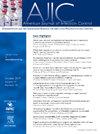COVID-19 infections among health care workers at a university hospital in Jeddah, Saudi Arabia
IF 3.8
3区 医学
Q2 INFECTIOUS DISEASES
引用次数: 0
Abstract
Background
The objective of this study was to describe the prevalence, characteristics, and risk factors of coronavirus disease-2019 (COVID-19) infection among health care workers (HCWs) at King Abdulaziz University Hospital, Jeddah, Saudi Arabia.
Methods
A prospective cross-sectional study of HCWs confirmed to have COVID-19 infection from March 1, 2020 to December 31, 2022.
Results
A total of 746 HCWs were diagnosed with COVID-19. Patients’ age ranged from 22 to 60 years with a mean ± standard deviation of 37.4 ± 8.7 years. The infection was community-acquired in 584 (78.3%) HCWs. The vast majority (82.6%) of the infected HCWs had no comorbidities. Nurses (400/746 or 53.6%) represented the largest professional group, followed by physicians (128/746 or 17.2%), administrative staff (125/746 or 16.8%), respiratory therapists (54/746 or 7.2%), and physiotherapists (39/746 or 5.2%). Symptoms included fever (64.1%), cough (55.6%), sore throat (44.6%), headache (22.9%), runny nose (19.6%), shortness of breath (19.0%), fatigue (12.7%), body aches (11.4%), diarrhea (10.9%), vomiting (4.4%), and abdominal pain (2.8%). Most (647 or 86.7%) patients were managed as outpatients. Four (0.5%) HCWs died.
Conclusions
HCWs face a dual risk of SARS-CoV-2 infection, both from community exposure and within the hospital setting. Comprehensive infection control strategies are needed to protect HCWs both inside and outside the hospital environment.
沙特阿拉伯吉达一所大学医院的医护人员感染 COVID-19。
目的:描述沙特阿拉伯吉达阿卜杜勒阿齐兹国王大学医院医护人员感染 COVID-19 的流行率、特征和风险因素:描述沙特阿拉伯吉达市阿卜杜勒阿齐兹国王大学医院(King Abdulaziz University Hospital)医护人员(HCWs)感染COVID-19的流行率、特征和风险因素:方法:对 2020 年 3 月 1 日至 2022 年 12 月 31 日期间确认感染 COVID-19 的医护人员进行前瞻性横断面研究:结果:共有 746 名医护人员被确诊感染 COVID-19。患者年龄在 22-60 岁之间,平均年龄(标准差)为 37.4±8.7 岁。584名(78.3%)人机工程人员的感染是在社区获得的。绝大多数(82.6%)受感染的医护人员没有合并症。护士(400/746 或 53.6%)是最大的专业群体,其次是医生(128/746 或 17.2%)、行政人员(125/746 或 16.8%)、呼吸治疗师(54/746 或 7.2%)和物理治疗师(39/746 或 5.2%)。症状包括发烧(64.1%)、咳嗽(55.6%)、喉咙痛(44.6%)、头痛(22.9%)、流鼻涕(19.6%)、呼吸急促(19.0%)、疲劳(12.7%)、全身酸痛(11.4%)、腹泻(10.9%)、呕吐(4.4%)和腹痛(2.8%)。大多数病人(647 人或 86.7%)都是门诊病人。4名(0.5%)医护人员死亡:结论:医护人员面临着感染 SARS-CoV-2 的双重风险,既有来自社区的感染,也有在医院环境中的感染。需要采取全面的感染控制策略来保护医院内外的高危工作者。
本文章由计算机程序翻译,如有差异,请以英文原文为准。
求助全文
约1分钟内获得全文
求助全文
来源期刊
CiteScore
7.40
自引率
4.10%
发文量
479
审稿时长
24 days
期刊介绍:
AJIC covers key topics and issues in infection control and epidemiology. Infection control professionals, including physicians, nurses, and epidemiologists, rely on AJIC for peer-reviewed articles covering clinical topics as well as original research. As the official publication of the Association for Professionals in Infection Control and Epidemiology (APIC)

 求助内容:
求助内容: 应助结果提醒方式:
应助结果提醒方式:


